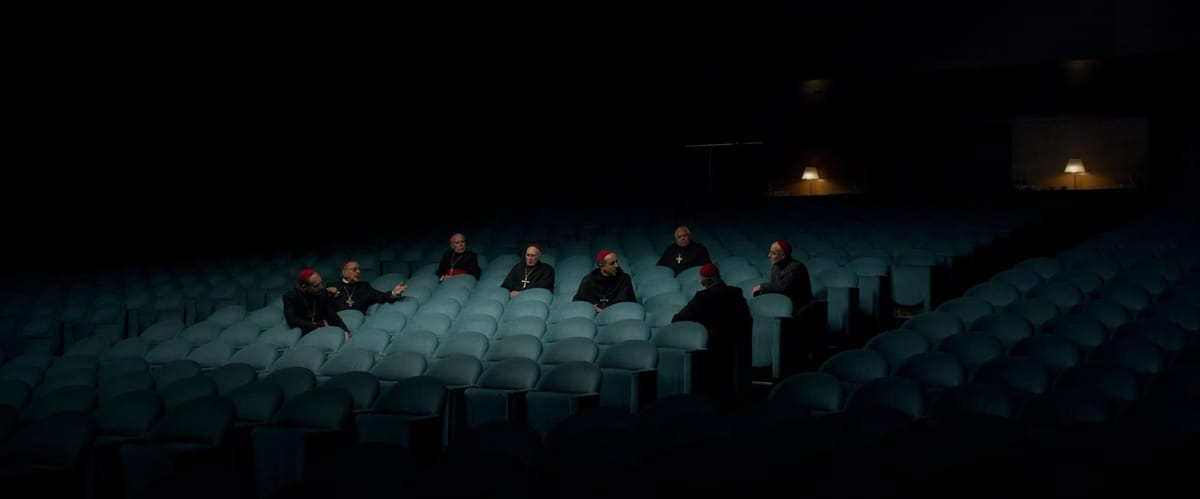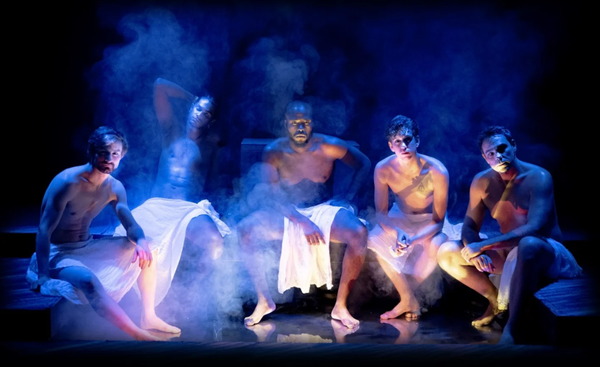In honour of uncertainty
Tradition and transition coexist in Conclave (2024)

This post contains no major or detailed spoilers for Conclave, only discussion and analysis of overarching themes with decontextualised quotes.
"I know what it is to exist between the world's certainties."
There is something elusive about the moment when transformation takes place. We can point to the past, which has been lived and known, and we can point to the effects of change. But we can never quite put our finger on the instant itself.

In his frescoes on the Sistine Chapel's ceiling, Michelangelo doesn't give attention to the consequence of an action. Instead, he chooses to depict the instant just before – the flash of anticipation. The Separation of Lightness and Darkness shows God immersed in his act, while in The Creation of Eve, Eve emerges from Adam's side, not yet fully stepping into her form. The Temptation and Expulsion from the Garden is not in the eating of the apple but rather in the reaching for the fruit. And, of course, The Creation of Adam is the outstretched arms, God's finger milliseconds away from bringing life to Adam's body.
Like Michelangelo's artworks, Edward Berger's Conclave is about a moment of suspenseful anticipation. The film is an adaptation of Robert Harris's novel that follows Cardinal Lawrence (Ralph Fiennes), who must untangle a web of conspiracies in the midst of leading the Catholic Church's election of a new pope. Conclave is a gripping thriller exploring the intermediary space that, while brimming with divine spark, is clouded by doubt, fear, and uncertainty.
:max_bytes(150000):strip_icc():focal(999x0:1001x2):format(webp)/conclave-042125-1-26dde0b577374cf1badd6d676a47edac.jpg)
Between the past and the future is an ongoing yet indescribable series of evolution, and Conclave is not afraid to linger within that murky epicentre.
Conclave is characterised by two juxtaposing aesthetics. The first being the airy ornateness of the Renaissance with its balanced compositions, rational composure, and even lighting. And the second being its successor, the Baroque, which drives its narratives with dramatic energy, asymmetry, and stark contrasts between light and dark (or, chiaroscuro). The movie embodies this contrast in aspects like set design, which juxtaposes Renaissance qualities, such as those in the Sistine Chapel, with the cardinals' stark living quarters at Casa Santa Marta. Yet, within these juxtapositions is a nuanced layering that unsettles the clean division we're tempted to draw between them.
In the Casa Santa Marta's aula, a group of progressive cardinals strategise their message to potential supporters: "Tell them I stand for respecting other faiths, tolerating other views within our own Church". Their figures and the blue seats are striking against the near black background as they sit scattered across the centre of the room. The scene's composition and lighting are immediately reminiscent of Baroque style but are then contradicted by the conversation's restrained tone, which evokes a Renaissance mood.
Conclave is not a film of outspoken theatrics. Expressed through its eerie score, the movie's drama bellows beneath the surface, threatening to disturb the seemingly stable legs of tradition. It nests even in the underbelly of the Renaissance's ethereality – the Sistine Chapel being cast into gloom during the sequestration. It's by stepping into this passage between two certainties, Renaissance and Baroque, that gives rise to Conclave's tension and discomfort of departing from what's known.

The Church is defined by its traditions, many of which are easily criticised for their outdatedness, including the involvement of women in religious roles.
Conclave highlights this representation of women by showing the nuns in the film delegated to housekeeping tasks in the cardinals' living quarters. With the exception of two characters, the nuns are anonymous figures who move around with silent yet hasty purpose – audible words spoken only in response to the cardinals they serve. However, at a decisive point in the movie's plot, one nun is granted a significant moment of being heard within the headquarters of the Church's patriarchal structure.
"Although we Sisters are supposed to be invisible, God has nevertheless given us eyes and ears," she says before bowing to make her exit. The monologue is a rare, blatantly spoken truth compared to the cardinals' cryptic and deceitful communication throughout the film. But this doesn't mark an equalising of genders in the story. Rather, it signals a glimpse of expectancy for something unexpected that is about to shift into place.
Conclave's narrative about the Catholic Church's mysterious and age-old custom of electing a pope is steeped in the contemporary: x-ray machines, cardinals with smartphones, and what's now become the most infamous vape hit in cinema. It's a film that makes the point that even historic institutions are not immune to the passing of time or the fallibility that comes with being human. In this, Conclave challenges us to envision a near future where tradition and transition can coexist.





